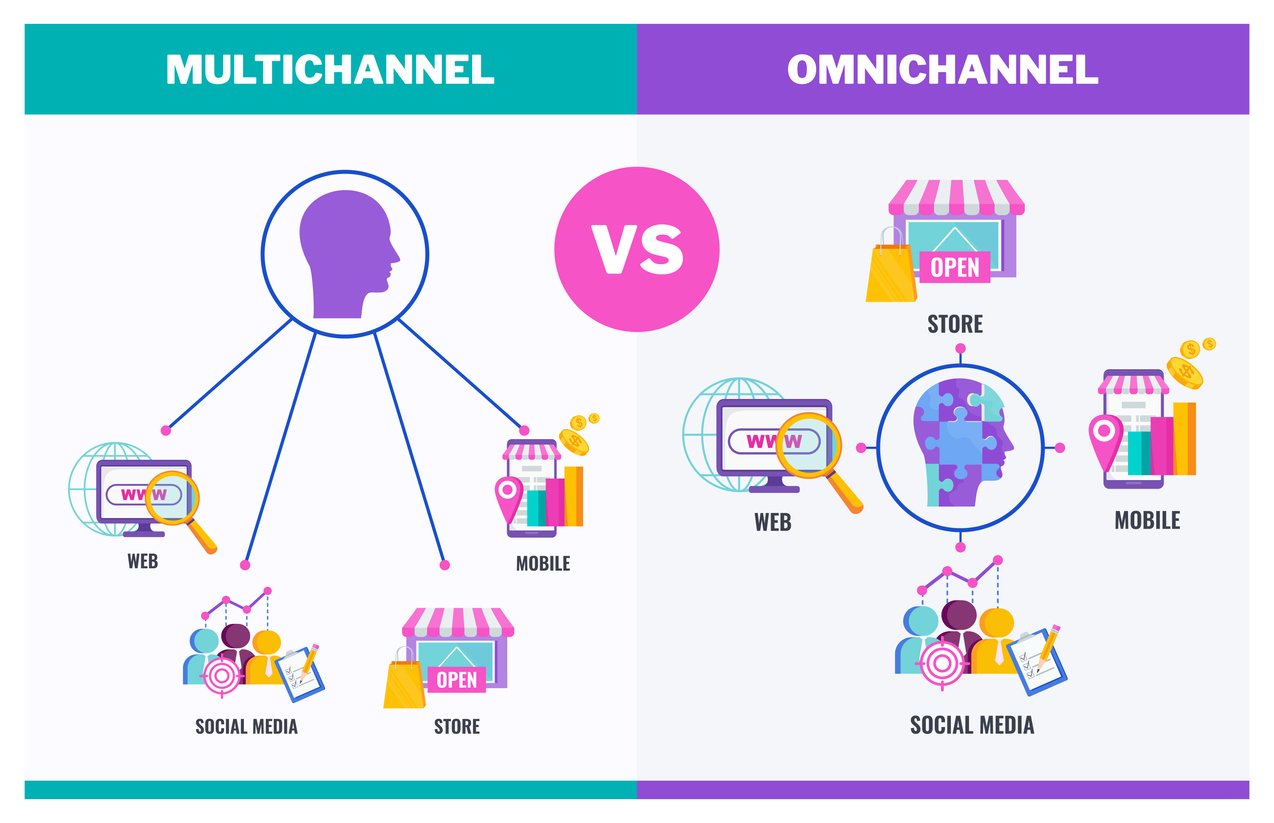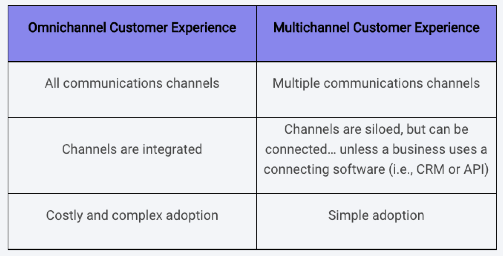Customers want to connect with brands across multiple channels on their preferred platforms. These shifting expectations have paved the way for two unique but often misconstrued customer experience (CX) approaches: omnichannel and multichannel.
The lines between omnichannel and multichannel customer experience often blur, and even though the terms are sometimes used interchangeably, they are not the same. Understanding the difference between omnichannel and multichannel is essential for businesses to enhance customer experience.
Back to Basics: What Is a Channel?
Before diving into the differences between omnichannel and multichannel CX, let’s go back to basics and go over what a channel is.
A channel is a medium a brand uses to communicate with customers and target audiences, and vice versa. Channels include email, phone calls, social media, websites, text messaging, online, and physical stores. Anywhere that communication between a brand and a stakeholder can happen is a channel.
There are typically two types of channels that brands rely on for communication: marketing channels and customer contact channels.
Marketing channels help brands grow awareness and promote their product or service. For example, advertisements on a billboard, signs in a physical store, or a company’s website copy and images are considered marketing channels. Contact channels are how customers can get in touch with a business — for example, by emailing, engaging in a live chat, or calling a contact center for support. In modern customer service landscapes, marketing and customer contact channels overlap.
Given the variety of channels brands and customers can use to communicate, businesses have turned to omnichannel and multichannel CX models to align CX goals better and create effortless communication with all stakeholders.

What Is Omnichannel CX?
As digital natives, most consumers switch between channels and devices throughout the day. For example, a potential customer could see an ad on Instagram and then visit a company’s website to make a purchase. Since consumers are tech savvy regarding channel usage, they expect brands to meet customers where they are and support their CX preferences.
With this in mind, an omnichannel strategy aims to ensure that customers don’t get lost or have to restart their journeys when switching between channels.
Omnichannel means all channels and is growing in popularity among industry experts. Omnichannel CX involves all potential customer touch points connecting seamlessly, regardless of channel. This seamless connection allows customers to pick up where they left off on one channel and continue their journey on another. A customer can start a support inquiry with a chatbot and then transfer to a live agent phone call without restarting their customer service request.
Information from each channel and interaction integrate for a better user experience. As a result, the user experience is more personalized, seamless, and contextual. Omnichannel CX relies on tools that unify sales, marketing, and support so that customers can jump between channels to continue their journey with a brand seamlessly.
One technology that supports an omnichannel CX is a customer data platform. This platform aggregates customer data across all channels to create more holistic customer profiles. Companies can improve the CX across channels with more accurate and detailed information about customers. However, genuinely connecting these channels can be challenging to achieve. Moreover, proper omnichannel support requires every employee to operate from the mindset of delivering and sharing a seamless and consistent CX.
Another barrier to omnichannel CX adoption is the cost and complexity of adopting new technologies that support it. Implementing omnichannel processes and communications across a business will likely require significant investment in technology and business adaptation.
What Is Multichannel CX?
Multichannel CX refers to using more than one channel to market your brand and communicate with stakeholders. These multiple channels are typically not integrated with each other, but they can communicate with each other through APIs.
Businesses opt for a multichannel strategy for CX to focus on being present where their customers are and seek to make each channel engaging and easy to use. Doing so can positively impact sales, customer retention, and customer satisfaction.
Businesses can use customer segmentation and customer journey mapping tools to identify improvements to their multichannel strategy and prioritize investments. A robust multichannel strategy can enhance CX and create a competitive advantage for businesses.
While omnichannel and multichannel CX both focus on communication across all channels, omnichannel goes the extra step by providing an integrated and optimized customer experience, with conversations seamlessly transferring across channels.
At-a-Glance: Omnichannel vs. Multichannel

Multichannel Strategy Use Case: Retail
E-commerce and online shopping continue to increase in popularity among consumers. This shift has forced brands to enhance retail CX from the digital shopping cart to the contact center. Technology such as AI-powered intelligent virtual agents (IVAs) helps companies improve customer support by enabling multichannel CX.
For example, retail contact center agents typically engage across various channels (e.g., phone, email, and social media) and resolve technical issues and detailed product questions. IVAs help retail organizations manage and enhance CX by delivering human-like messages across multiple channels. At the same time, IVAs can proactively suggest the next best action by leveraging customer data and past interactions without the support of a human agent.
Mosaicx transforms retail service by helping businesses deploy virtual agents to enhance CX.

Enhance CX with Mosiacx
Innovative and affordable contact center automation solutions allow brands to bridge the gap between channels. IVAs like Mosaicx help bridge the gaps between channels by meeting customers where they are. By bridging the gap, customers have more control over their journey with the brand, which leads to overall satisfaction.
Businesses can use solutions such as Mosaicx to offer a unified solution with various customer engagement and customer experience solutions. Companies can automate common customer inquiries, minimize wait times, establish easy AI-to-agent handoff, lower average call costs, enhance CX, and increase customer retention.
Mosaicx is more intelligent than traditional contact center solutions. It provides true automation, not just interactive voice response or automatic call distribution. Its software uses voice recognition, AI, and machine learning to help customers find information quickly and resolve issues without help from a human agent.
With Mosaicx, your company can build a dynamic multichannel strategy. Your customer support teams will deliver better customer service, elevate the overall customer experience, and promote customer loyalty.
Omnichannel vs. Multichannel: Final Review
Though they have notable differences, omnichannel vs. multichannel CX are two terms often misconstrued with each other. While they both emphasize all channels, omnichannel provides seamless connection, while multichannel focuses on communicating with stakeholders across all channels.
Companies can begin to bridge the gaps in CX with the use of conversational AI tools like Mosaicx. With Mosaicx, brands prioritizing a multichannel strategy and leveraging IVAs in their contact centers will gain a competitive edge and deliver a strong CX.
This post originally appeared on mosaicx.com.
Guest blog post written by Mosaicx. To learn more about this topic and others, visit the events page to check out all of our upcoming events.


